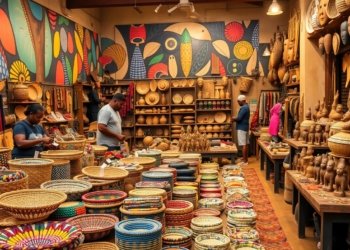What if the next wave of global innovation doesn’t come from Silicon Valley, but from Africa? With 60% of the continent’s population under 25, the region holds unmatched potential. Historically reliant on natural resources, countries like Kenya and Nigeria are now nurturing developer hubs rivaling global tech centers.
Major players like Microsoft and Google are investing in data science and AI training, recognizing this shift. Initiatives such as Mastercard’s EdTech Fellowship support local startups, while cities like Nairobi and Lagos fuel rapid growth in digital skills. The question isn’t whether Africa can compete—it’s how soon.
Key Takeaways
- Africa has the world’s youngest population, with 70% under 30 in sub-Saharan regions.
- Tech giants are funding programs to bridge the skills gap and foster innovation.
- Developer communities in Nairobi and Lagos are expanding rapidly.
- STEM training is seen as a catalyst for economic growth, mirroring US success.
- Youth unemployment challenges are being addressed through hands-on learning initiatives.
The Transformative Power of Tech Education for African Youth
The shift from raw materials to digital expertise is reshaping Africa’s economic future. Only 25% of high school students receive STEM training, yet regions like Kenya and Egypt show how closing this gap fuels growth. Nairobi’s iHub and Lagos’ Yaba Tech Cluster prove local talent can compete globally.
Bridging the Skills Gap with STEM
Outsourcing tech projects costs African economies billions annually. Initiatives like Andela’s developer training and Mozisha’s 83% job placement rate demonstrate scalable solutions. Cloud computing certifications now offer higher wages than traditional trades.
Career fairs reaching 500,000+ learners annually highlight rising demand. Women remain underrepresented, but groups like She Codes Africa are changing this. The World Bank ties STEM investment to 9% GDP growth projections.
From Traditional Exports to Tech Talent
Silicon Savannah’s 200+ startups attract investors eyeing low-cost, high-skill labor. North Africa’s cultural ties to Europe give it an edge in outsourcing. Meanwhile, South Africa’s universities align curricula with AI and blockchain trends.
Hands-on learning replaces outdated methods. AYM’s workshops reach 2.3 million, while ALX trains thousands in IoT. The continent’s potential hinges on turning raw talent into market-ready skills.
Key Initiatives Driving Tech Education Across Africa
Collaborative efforts are unlocking digital potential across the continent. Public-private partnerships and grassroots programs are creating scalable solutions to close the skills gap. From Lagos to Nairobi, these models combine cutting-edge tools with localized strategies.

Government and Corporate Partnerships
Google’s Digital Skills for Africa has trained 6 million people since 2016. Microsoft’s African Development Center now prepares 500 engineers monthly. Rwanda’s Coding Academy and Egypt’s STEM schools show how policy fuels growth.
The Dangote Foundation’s $100M fund supports vocational training. These alliances prioritize AI, blockchain, and IoT—fields driving economic growth.
Grassroots Programs Making Waves
AYM’s three-tier approach—workshops, mentorship, and challenges—reaches 15 countries. Their mobile apps deliver offline learning to remote areas. Mozisha’s AR modules reduce the IoT skills gap by 40% through hands-on simulations.
EdTech Breakthroughs
Eneza Education serves 4 million users via SMS-based quizzes. Nigerian universities now verify credentials with blockchain. In Kenya, IoT projects teach smart agriculture at vocational schools.
Radio programs bridge connectivity gaps, reaching 3 million rural students weekly. Such innovation proves adaptable tools can overcome infrastructure barriers.
Challenges and Opportunities in Africa’s Tech Education Landscape
Africa’s digital revolution faces hurdles in infrastructure but thrives in emerging fields like AI and blockchain. While 600 million people lack electricity, innovators are turning constraints into opportunities. The continent’s tech potential is undeniable, yet bridging the gap requires tackling systemic barriers head-on.

Infrastructure and Access Barriers
Only 28% of schools have computer labs, and 40% lack internet. Power outages affect 65% of rural learning centers. Creative solutions like Malawi’s solar-powered hubs and Kofa’s battery networks are filling the void.
Public-private partnerships are critical. Rwanda allocates 5.6% of GDP to train 1.5 million in coding. Mobile platforms reach remote students, but device affordability remains a hurdle.
High-Demand Fields: AI, Blockchain, and IoT
Africa’s AI market will hit $6.9 billion by 2025. Startups like Andela’s $200M fund back Swahili NLP models and healthcare diagnostics. Blockchain adoption grows at 400% annually, streamlining land registries in Ghana.
IoT transforms cities—Lagos prototypes smart traffic systems. Cloud certifications now outearn degrees, proving skills trump traditional paths. The key? Aligning curricula with these fast-evolving technologies.
Conclusion: Shaping Africa’s Future Through Technology
Africa’s young minds are rewriting the rules of global innovation. With 70% of the population under 30, the potential is unmatched. Programs like AYM and Mozisha prove scalable solutions exist, reaching millions.
Standardized certifications and pan-African frameworks can accelerate growth. Climate tech and AI ethics offer new frontiers. Cross-border collaboration will turn raw talent into market-ready skills.
Support these initiatives today. By 2040, Africa won’t just compete—it will lead.
FAQ
How does STEM learning help bridge the skills gap in Africa?
STEM programs focus on science, technology, engineering, and math, equipping young learners with in-demand abilities. These skills prepare them for high-growth industries, reducing unemployment and boosting economic growth.
What role do government and corporate partnerships play in tech training?
Collaborations between policymakers and businesses provide funding, infrastructure, and job placements. Initiatives like Andela and Google’s Africa Developer Training expand access to digital skills across the continent.
How are mobile learning platforms transforming education in rural areas?
Apps like M-Shule and Eneza deliver lessons via smartphones, reaching underserved communities. This approach overcomes distance barriers, offering interactive content even with limited internet access.
Which emerging technologies offer the best career opportunities for African students?
Fields like artificial intelligence, blockchain, and IoT are growing rapidly. Companies seek talent in these areas, creating pathways for innovation and entrepreneurship in local markets.
What challenges do grassroots programs face in delivering quality instruction?
Limited electricity, outdated devices, and teacher shortages hinder progress. However, solar-powered labs and peer-to-peer mentoring models are proving effective solutions in many regions.





